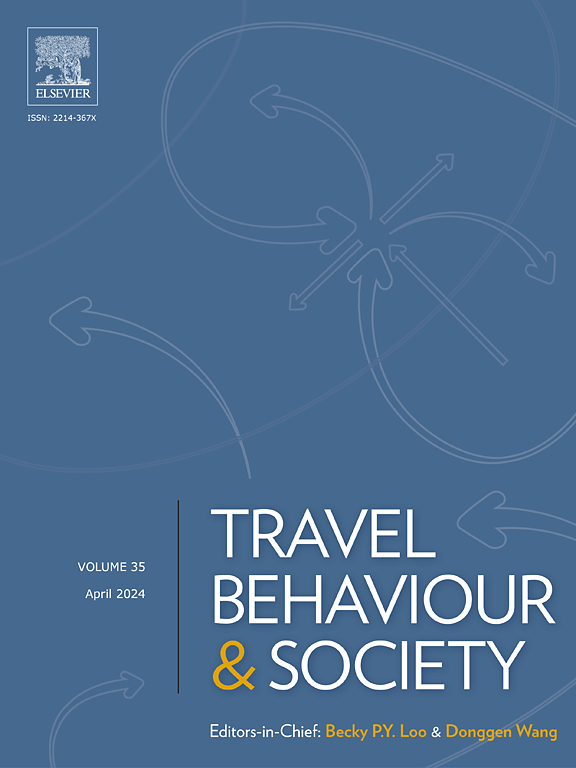打车软件的使用、出行模式和多模式:对加利福尼亚州基于全球定位系统的一周旅行日记的潜类聚类分析
IF 5.1
2区 工程技术
Q1 TRANSPORTATION
引用次数: 0
摘要
本研究基于对加利福尼亚州四大都市区一周 GPS 旅行日记数据的分析,进行了潜类聚类分析,并确定了四个具有不同程度多式联运的独特旅行者群体。这些群体的特点是在工作和非工作出行中使用五种出行方式(即单人乘车、拼车、公共交通、骑自行车和步行)。其中有两个群体更倾向于使用汽车,而较少使用多种出行方式(即自驾车用户和拼车用户),而另外两个群体则不太倾向于使用汽车,但使用多种出行方式的程度较高(即公交用户和骑自行车者)。研究结果揭示了每个旅行者群体在社会人口特征和建筑环境属性方面的独特特征。研究还进一步调查了每个出行群体在采用打车服务、出行频率和出行属性方面的不同特征。研究发现,公交用户采用和使用打车服务的比例最高。与其他群体相比,他们也更倾向于使用集合打车服务。在出行方式替代方面,如果没有打车服务,受访者倾向于选择他们最常使用的出行方式。换句话说,以汽车为出行工具的受访者更倾向于以汽车出行替代打车出行,而非以汽车为出行工具的受访者则更倾向于以污染较少的出行方式替代打车出行。这项研究的结果将对公交机构和有兴趣将打车服务与其他交通方式相结合、促进多式联运和减少对汽车依赖的生活方式的政策制定者很有价值。本文章由计算机程序翻译,如有差异,请以英文原文为准。
Ridehailing use, travel patterns and multimodality: A latent-class cluster analysis of one-week GPS-based travel diaries in California
Based on the analysis of one-week GPS-based travel diary data from the four largest metropolitan areas in California, this study performs a latent-class cluster analysis and identifies four distinctive traveler groups with varying levels of multimodality. These groups are characterized by their distinctive use of five travel modes (i.e., single-occupant vehicles, carpooling, public transit, biking, and walking) for both work and non-work trips. Two of these groups are more car-oriented and less multimodal (i.e., drive-alone users and carpoolers), whereas the other two are less car-oriented and display higher levels of multimodality (i.e., transit users and cyclists). Results from this study reveal the unique profiles of each traveler group in terms of their sociodemographic characteristics and built-environment attributes. The study further investigates the different characteristics of each traveler group in relation to ridehailing adoption, trip frequency and trip attributes. Transit users are found to have the highest rate of ridehailing adoption and usage. They are also more prone to use pooled ridehailing services in comparison to other groups. In terms of mode substitution, if ridehailing were not available, respondents tend to choose the mode they use most frequently. In other words, car-based travelers are more likely to substitute ridehailing trips with car trips, whereas non-car-based travelers are more likely to replace ridehailing with less-polluting modes. The findings from this study will prove valuable for transit agencies and policymakers interested in integrating ridehailing with other modes and promoting more multimodal and less car-dependent lifestyles.
求助全文
通过发布文献求助,成功后即可免费获取论文全文。
去求助
来源期刊

Travel Behaviour and Society
TRANSPORTATION-
CiteScore
9.80
自引率
7.70%
发文量
109
期刊介绍:
Travel Behaviour and Society is an interdisciplinary journal publishing high-quality original papers which report leading edge research in theories, methodologies and applications concerning transportation issues and challenges which involve the social and spatial dimensions. In particular, it provides a discussion forum for major research in travel behaviour, transportation infrastructure, transportation and environmental issues, mobility and social sustainability, transportation geographic information systems (TGIS), transportation and quality of life, transportation data collection and analysis, etc.
 求助内容:
求助内容: 应助结果提醒方式:
应助结果提醒方式:


